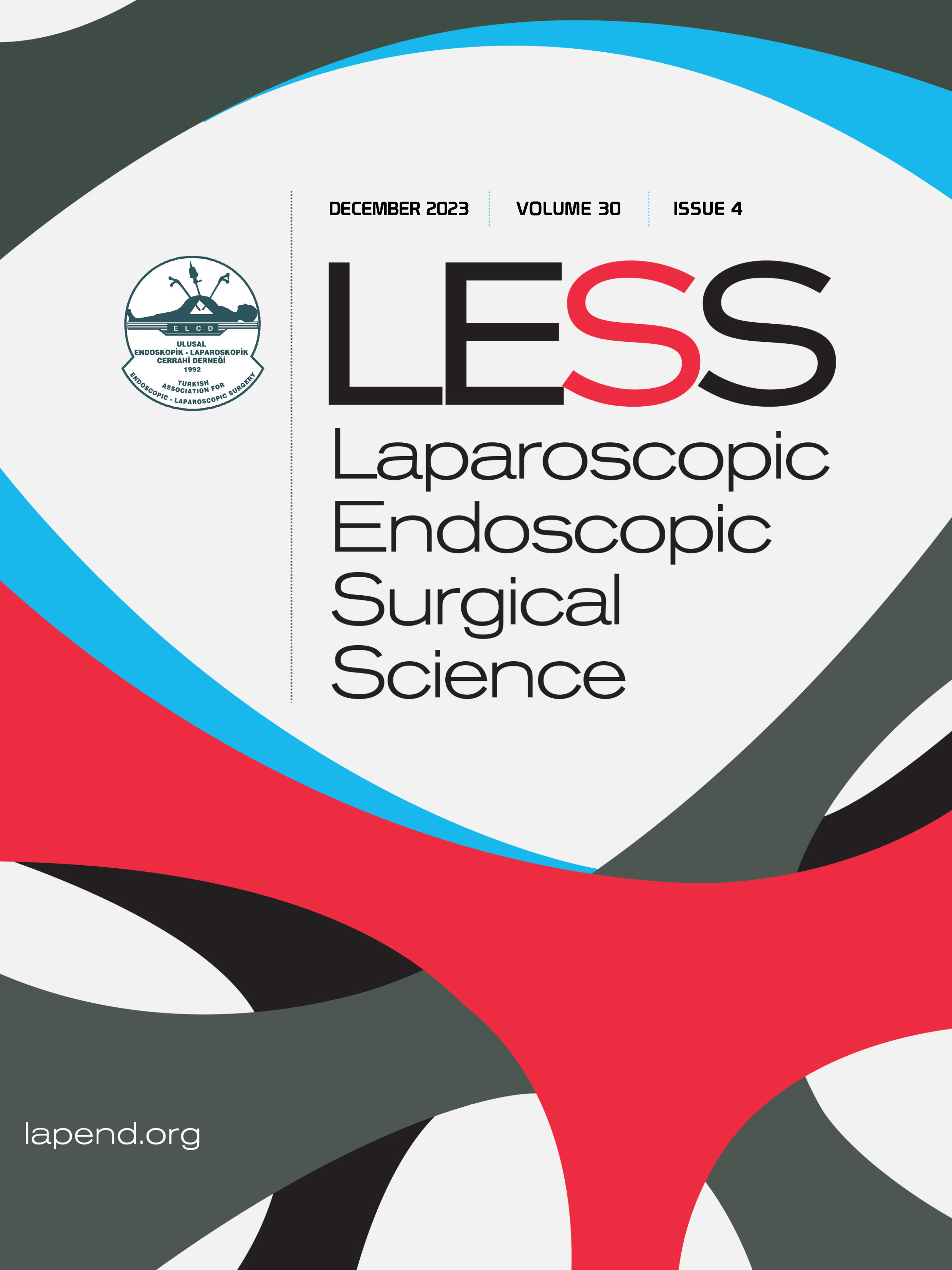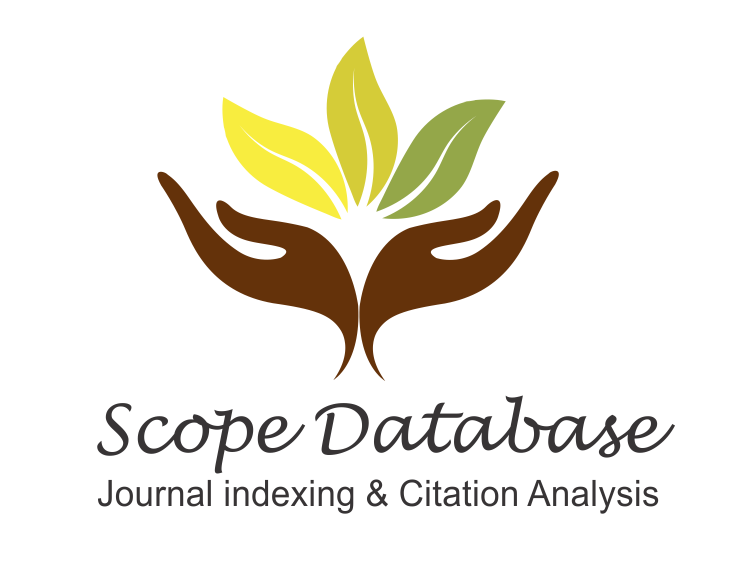Volume: 25 Issue: 3 - 2018
| 1. | Front Matter 2018-3 Pages I - IV |
| RESEARCH ARTICLE | |
| 2. | Efficacy of endoscopic vascular staplers for splenic hilar control during laparoscopic splenectomy Barış Özcan, Metin Çevener, Burak Deveci, Ihsan Karadoğan, Okan Erdoğan doi: 10.14744/less.2018.59489 Pages 87 - 92 INTRODUCTION: This study aimed to assess the results and effectiveness of using endoscopic vascular staplers for splenic hilar control in 36 consecutive cases who underwent elective laparoscopic splenectomy due to hematologic problems. METHODS: Thirty-six consecutive patients who underwent laparoscopic splenectomy (LS) due to hematologic diseases over a 3-year period between January 2012May 2015 were included in this study. LS was carried out with the standard 4-port method. All hilar vessels were divided by using an endoscopic stapler loaded with vascular cartridges. Patient demographic data, hematologic diagnosis, size of the spleen, duration of operation, length of hospital stay, post-operative complications, postoperative analgesic requirement were retrospectively extracted from patient files. RESULTS: A total of 36 consecutive patients were treated in a single center and were operated by two surgeons. There was no conversion to laparotomy or reoperation in the series. One patient developed acute portal vein thrombosis that was medically treated in the early post-operative period. Another patient experienced pneumothorax due to a diaphragmatic injury that was repaired during surgery. The average spleen size was identified as 14.5 cm. An accessory spleen was detected in 5 patients. The mean operative time was 97 minutes, and the mean length of hospital stay was 2.3 days. DISCUSSION AND CONCLUSION: We believe that using an endoscopic vascular stapler for ligation of hilar vascular structures during elective laparoscopic splenectomy by experienced surgeons is efficient despite the cost disadvantage. |
| 3. | Histopathological findings and helicobacterpylori infection frequency in 816 sleeve gastrectomy materials for morbid obesity Özgen Arslan Solmaz, Hadice Akyol, Fatih Erol doi: 10.14744/less.2018.36449 Pages 93 - 97 INTRODUCTION: Morbid obesity is severe obesity that threatens and shortens a persons life. Today, surgery is almost the only treatment method that has been proven to treat morbid obesity. Endoscopic gastric examination is not performed preoperatively due to the complications that are associated with gastric pathologies that have not been defined. There are few studies for the purpose of determining histopathological findings in cases of sleeve gastrectomy specimens. It is thought that some postoperative complications may be related to existing histopathologic findings. METHODS: Preparations of 816 sleeve gastrectomy specimens examined in the pathology laboratory were reevaluated and evaluated histopathologically. RESULTS: Fifty-seven percent of 816 patients (n=465) showed no significant anomaly. Fourteen percent (n=114) showed non-Helicobacter-related gastritis. In 26% (n=212) of cases, Helicobacter pylori-associated gastritis was detected, and in 0.36% (n=3) of cases,specific gastritis (lymphocytic gastritis) was found. In 2.64% (22) of cases, intestinal metaplasia was observed. H.pylori was negative in 72% (n=588) and positive in 28% (n=228) of cases. DISCUSSION AND CONCLUSION: We concluded that H.pylori infections do not have a risk of postoperative complications. However, if premalignant lesions, such as intestinal metaplasia, are suspected, we believe that preoperative endoscopic examination of the stomach should be performed. |
| 4. | Laparoscopic treatment of hepatic hydatid disease: Şanlıurfa-Turkey experience and early clinical outcomes Mehmet Ali Gök, Mehmet Tolga Kafadar, Abdullah Güneş doi: 10.14744/less.2018.43531 Pages 98 - 102 INTRODUCTION: Cyst hydatid disease is still our territory and remains a common health problem for our country. In this clinical retrospective study, cases of liver hydatid cysts treated as laparoscopic were analysed. METHODS: Medical records of 25 patients (16 female, 9 male; mean age 41±3.42; range 2078) who were treated for hepatic hydatid disease in our clinic between June 2016 and June 2017 were retrospectively reviewed. Patients were evaluated in terms of age, sex, location of cyst, surgical method applied, duration of hospital stay, postoperative complications and treatment methods for complications. RESULTS: One patient (4%) due to intraperitoneal rupture was operated urgently. In 5 (20%) of the cases, bile leakage were seen in the cyst sponge during the operation and perioperative laparoscopic suture was performed. In three of these patients (12%), the leakage was closed without any intervention, two (8%) lasted more than a week and the daily flow was over 150 cc. Endoscopic sphincterotomy was applied to these cases. DISCUSSION AND CONCLUSION: Nowadays at experienced centers, laparoscopic surgical interventions in selected patients take place in the treatment algorithm as an effective and safe method for the treatment of liver cyst hydatid disease. We think that uncomplicated hydatid cysts do not need specialized laparoscopic instruments in the surgery. |
| 5. | Retrospective analysis of clinical and surgical results of 123 patients prediagnosed with acute appendicitis Necip Altundas, Umut Orkun Celebi doi: 10.14744/less.2018.38358 Pages 103 - 109 INTRODUCTION: Acute appendicitis is a disease requiring urgent surgical intervention. It is frequently encountered in general surgical clinics. Maintaining a good medical record and physical examination are the first priorities in diagnosing appendicitis. This study aimed to evaluate the clinical and surgical results of patients prediagnosed with acute appendicitis in a Erzurum Oltu State Hospital. METHODS: The records of the 123 patients [49 (39.8%) female and 74 (60.2%) male], who were diagnosed with acute appendicitis in the hospital between 2015 and 2017, were retrospectively analyzed in terms of age, gender, Alvarado score, and laboratory and radiology findings. Furthermore, surgical methods were examined with regard to the duration of surgery, hospitalization, and complications. RESULTS: A total of 32 (26%) patients were scanned with ultrasonography (US), 91 (74%) with computed tomography (CT), and 12 (9.7%) with both US and CT. Laparoscopic appendectomy (LA) was performed in 66 (53.6%) patients, and open appendectomy (OA) in 57 patients (46.4%). Further, 71 (57.8%) of the 120 patients with intraoperatively diagnosed appendicitis had suppurative, 38 (30.9%) had catarrhal, 8 (6.5%) had perforated, 3 (2.4%) had gangrenous appendicitis. The histopathological and intraoperatively diagnosis of the remaining 3 (2.4%) patients was normal. Three (2.4%) of the patients who underwent OA developed ileus, and one (0.8%) patient had wound infections. One (0.8%) patient who underwent LA developed ileus. DISCUSSION AND CONCLUSION: The effective use of laboratory, scoring, and assisted imaging methods can reduce the rates of negative appendectomy and postoperative complications. Laparoscopic surgery has a positive effect on postoperative pain and quality of life. If laparoscopic equipment and experience with the method are sufficient, the first choice should be laparoscopic surgery for acute appendicitis. |
| CASE REPORT | |
| 6. | Laparoscopic repair in a case with Morgagni hernia Adil Başkıran, Kutay Sağlam, Abuzer Dirican doi: 10.14744/less.2018.63935 Pages 110 - 112 Morgagni hernia is herniation of the abdominal contents through a congenital retrosternal defect to the thoracic cavity. In the present study we report a case of 40 years old male patient who was admitted to our department with signs of intestinal obstruction and dyspnea and was diagnosed as incarcerated Morgagni hernia. The diagnosis was established with direct chest radiograms and thorax computerized tomography. Following the reduction of the omentum and the colon segment in the hernia, the defect was sutured primarily and the repair was reinforced by a dual mesh. In patients with constipation and obstipation possibility of presence of Morgagni hernia should be kept in mind and proper investigative measures should be obtained. |
| 7. | Totally laparoscopic approach for a single mesenteric localization of Castelmans disease: state of the art of laparoscopic surgery Nicolò Fabbri, Serena Rubino, Sara Giaccari, Cristina Bombardini, Giorgia Santandrea, Luigi Romeo, Franceca Petrarulo, Massimo Pedriali, Gabriele Anania doi: 10.14744/less.2018.91885 Pages 113 - 116 Castlemans disease is a rare proliferative disorder of benign nature characterized by hyperplasia of the lymphoid follicles. The abdomen is rarely affected by this pathology. The difficult preoperative diagnosis has recently led laparoscopic surgery to become an option for diagnosis and treatment of the unicentric form of the disease. Herein we present a literature review reporting our experience representing, according to our knowledge, one of the first cases of totally laparoscopic resection of single abdominal localization of Castelmans disease. |
| 8. | Portomesenteric and splenic vein thrombosis after laparoscopic sleeve gastrectomy Saliha Karagöz Eren, Olcay Çınar, Alican Yalı, Sedat Çarkıt, Ömer Topuz, Tamer Ertan doi: 10.14744/less.2018.49469 Pages 117 - 120 Portomesenteric venous thrombosis (PVT) is a rare and life-threatening complication after laparoscopic bariatric surgery. Laparoscopic sleeve gastrectomy (LSG) is one of the most popular methods of bariatric surgical procedures. We aimed to present a 27-year-old male patient who presented with thrombosis in the portal vein, superior mesenteric vein, and splenic vein following LSG. Patient presented with widespread abdominal pain in the epigastric region, loss of appetite, and constipation at the postoperative 41st day; in color Doppler ultrasonography and computerized tomography, thrombosis was detected in portal vein and branches, splenic vein, portal confluence level, and superior mesenteric vein. The patient was given antithrombotic therapy and discharged without symptoms. The incidence of portal vein thrombosis has steadily increased with the increased number of laparoscopic bariatric operations. It requires a high degree of clinical suspicion as it presents with nonspecific symptoms. PVT should be considered in cases with atypical abdominal pain after bariatric surgery. |
| 9. | Autologous mesenteric vein and peritoneum for repair of portal vein and hepatic artery injuries accompanying bile duct injury following laparoscopic cholecystectomy Volkan Ince, Sertaç Usta, Tamer Ertan, Halil Armağan, Cüneyt Kayaalp doi: 10.14744/less.2018.71224 Pages 121 - 124 Biliary tract injuries are still the most hazardous complications of laparoscopic cholecystectomy. Concomitant vascular injuries make them further more complicated and complex surgical interventions including autologous grafting can be required. We presented a 32-year-old female referred us with combined bile duct, portal vein and hepatic artery injuries occurred during laparascopic surgery. The repairs of hepatic artery and portal vein were achieved by autologous inferior mesenteric vein and peritoneum grafts, respectively. Bile duct reconstruction was done by Roux-en-Y hepaticojejunostomy. Postoperative course was uneventful and she was asymptomatic following 16 months follow-up. Autologous vein and peritoneal grafts can be used for repair of vascular injuries of laparascopic cholecystectomy. |
| LETTER TO THE EDITOR | |
| 10. | Falciform ligament instead of mesh for mini-laparoscopic hiatal hernia repair Kuntay Kaplan, Cihan Gökler, Mehmet Can Aydın, Cüneyt Kayaalp doi: 10.14744/less.2018.02259 Pages 125 - 127 Abstract | |
| 11. | Rectovaginal fistula development after NOSE in robotic low anterior resection for rectum adenocarcinoma Ismail Gomceli, Umit Koc, Mazlum Yavas, Salih Can Celik doi: 10.14744/less.2018.49369 Pages 128 - 129 Abstract | |
| 12. | Iliac artery injury during trocar entry in laparoscopic surgery Mehmet Can Aydın, Cihan Gokler, Kuntay Kaplan, Cüneyt Kayaalp doi: 10.14744/less.2018.52533 Pages 130 - 131 Abstract | |















